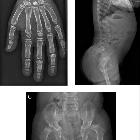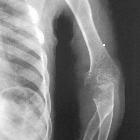Multiple epiphysäre Dysplasie

Dual novel
mutations in SLC26A2 in two siblings with multiple epiphyseal dysplasia 4 from a Chinese family: a case report. Radiographs and clinical features of patient 1. Hip radiographs revealed coxa plana at the ages of 7 and 12 years (a). Spinal radiographs confirmed the progress of scoliosis (b). Hand radiographs confirmed the brachydactyly and significantly flattened articular surface (c–d)

Dual novel
mutations in SLC26A2 in two siblings with multiple epiphyseal dysplasia 4 from a Chinese family: a case report. Hip radiographs of patient 2 during the ages from 3 to 6 years. Roentgenologic bone survey showed hip dysplasia with the following abnormalities: both femoral necks were short with flattened heads, acetabulum dysplasia, and secondary ossification center of femur dysplasia

A novel COMP
mutation in a Chinese family with multiple epiphyseal dysplasia. The clinical and radiological characteristics of the proband. Clinical and radiological appearance of proband (III-10) showing (a) limitation of movement in the lumbar spine, (b) flatfoot on both sides, and (c) the avascular necrosis of the bilateral femoral heads

A novel COMP
mutation in a Chinese family with multiple epiphyseal dysplasia. The radiological characteristics of an affected patient (II-13). Radiological assessment of a patient (II-13) showing (a) the brachydactyly of the both hands, (b) shallow femoral trochlear grooves and slightly squared femoral condyle in the knees, (c) the avascular necrosis of the bilateral femoral heads, and (d) flatfoot on both sides

Multiple
epiphyseal dysplasia • Multiple epiphyseal dysplasia - Ganzer Fall bei Radiopaedia

Double-Layered
Patella (DLP) in Multiple Epiphyseal Dysplasia (MED): Sagittal PD fat-sat image confirming the double-layered patella. This image also demonstrates a significant intra-articular fluid effusion, as well as some fluid in the Hoffa patpad. A: anterior patellar segment; P: posterior patellar segment.
Multiple epiphyseal dysplasia (also known as dysplasia epiphysealis multiplex or Fairbank disease) is a type of non-rhizomelic dwarfism characterized by flattening and fragmentation of epiphyses.
Pathology
Multiple epiphyseal dysplasia is inherited in an autosomal dominant pattern.
Radiographic features
- delayed and irregular secondary ossification centers
- flattened and squared-off epiphyses
- thinning of the lateral tibial epiphysis
- double-layered patella
- hypoplastic tibial and femoral condyles with shallow intercondylar notch
Siehe auch:

 Assoziationen und Differentialdiagnosen zu Multiple epiphysäre Dysplasie:
Assoziationen und Differentialdiagnosen zu Multiple epiphysäre Dysplasie:




